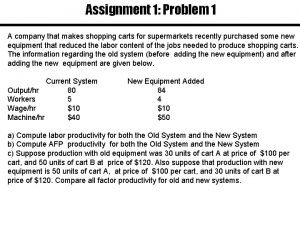Transactions Case Study Transactions at the Supermarkets PayDesk















- Slides: 15

Transactions: Case Study Transactions at the Supermarket’s Pay-Desk Svetlin Nakov National Academy for Software Development academy. devbg. org

Session and Transaction: Case Study • We have a supermarket and we need to process orders • An order is a set of order items (product, quantity) entered with a bar-code reader • Processing a set of order items can take few minutes • We should keep the transactions small to allow high concurrency • What we can do?

Solution 1 Add Each Item in Separate Transaction

Case Study: Solution 1 • Create an order in state active=false, save it and commit the transaction • Commit a transaction for each order item • Persist orders items in the database in active=false state • If save of order item fails, rollback the transaction and correct the invalid item • Finally start an additional transaction, process the payment and commit it • Change the order state to active=true

Case Study: Solution 1 • We have a series of small transactions • Don’t keep long transactions in the DB • Works well for Web applications • How to deal with the following: • Customer takes the last bottle of vodka but does not checkout • Next customer comes and no vodka is available and goes off • The first customer cancel his order • We have 2 customers but have no sale

Solution 2 Keep Long Transaction Perform Critical Changes in the Last Moment

Case Study: Solution 2 • Create an order and keep the transaction open during the processing of this order • For each order item save it in the database and post the changes to DB • If save fails correct the invalid item and post it again (transaction is kept open) • Finally process the payment (update product amounts and cash amounts) and commit the transaction • If something fail, rollback the entire transaction

Case Study: Solution 2 • We have only one transaction • We kept it open for a long (few minutes) • We add order items without changing the amount of ordered products • Finally we change shared data (cash amount and product amounts) just before commit, when the customer pays • The transaction is long but the time we keep locked records in small (few milliseconds)

Case Study: Solution 2 • At the final stage some products can be unavailable • We still use optimistic locking • This gives good scalability • Good for desktop applications only! • When concurrent users are not too much • Not applicable for Web scenario

Solution 3 Disconnected Model Keep All Changes in the Memory; Small Transaction Commits All of Them at Once

Case Study: Solution 3 • Don't start any session and transaction • Create an order in memory only (in transient objects) • For each order item create it in memory only (in transient objects) • Immediate data validation is not possible! • Finally start session and transaction, save the order and order items, process the payment and commit the transaction • If something fail, rollback the transaction

Case Study: Solution 3 • Classical “disconnected model” • Efficient, optimistic locking • Hard to implement • If an order item fails to post in the DB, the entire order should be canceled • No way to correct one item • Good for mobile applications • Avoid in Web and Desktop scenarios

Solution 4 Just Pessimistic Locking

Case Study: Solution 4 • Start a transaction with serializable isolation level • For each order item immediately post changes in the database • Immediately correct the products availability and cash amount • Finally commit the transaction • Concurrent customers should wait each other • No concurrent transactions

Transactions: Case Study Questions?
 Best worst and average case
Best worst and average case Project failure case study
Project failure case study Big 4 supermarkets
Big 4 supermarkets Reed supermarkets a new wave of competitors
Reed supermarkets a new wave of competitors Theory of shopping
Theory of shopping As a type of retailer category specialists offer
As a type of retailer category specialists offer A company that makes shopping carts for supermarkets
A company that makes shopping carts for supermarkets Hình ảnh bộ gõ cơ thể búng tay
Hình ảnh bộ gõ cơ thể búng tay Frameset trong html5
Frameset trong html5 Bổ thể
Bổ thể Tỉ lệ cơ thể trẻ em
Tỉ lệ cơ thể trẻ em Chó sói
Chó sói Glasgow thang điểm
Glasgow thang điểm Hát lên người ơi
Hát lên người ơi Môn thể thao bắt đầu bằng chữ đua
Môn thể thao bắt đầu bằng chữ đua Thế nào là hệ số cao nhất
Thế nào là hệ số cao nhất



























